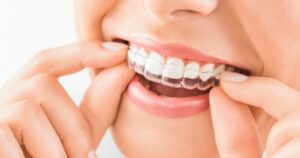Have you ever wondered if there’s a connection between orthodontics and a good night’s sleep? You might be surprised to learn that the alignment of your teeth and jaw can indeed play a significant role in addressing sleep apnea, a condition that affects millions of people worldwide. At My Smile Orthodontics, we believe in the transformative power of orthodontic treatment, not only for achieving a beautiful smile but also for improving overall well-being.
In this article, we’ll delve into the intriguing topic of whether Invisalign, a cutting-edge orthodontic solution, can help with sleep apnea. We’ll explore the fundamentals of sleep apnea, the role of orthodontic treatment, and the potential benefits that Invisalign may offer for those seeking relief from this sleep disorder. At My Smile Orthodontics, we’re committed to providing you with the latest insights into orthodontics and how it can positively impact your life.
So, if you’ve ever wondered whether Invisalign could be the key to a better night’s sleep, read on to discover the exciting possibilities that modern orthodontics can offer. Your journey to a healthier, more restful sleep starts here.
Understanding Sleep Apnea
Before we delve into the potential benefits of Invisalign for addressing sleep apnea, let’s first understand what sleep apnea is and why it’s a matter of concern for many individuals.
Sleep apnea is a common sleep disorder characterized by interruptions in breathing during sleep. These interruptions, known as apneas, can be brief but frequent, leading to reduced airflow or complete cessation of breathing. There are three primary types of sleep apnea:
Obstructive Sleep Apnea (OSA)
This is the most prevalent form of sleep apnea. It occurs when the muscles at the back of the throat relax excessively during sleep, causing a partial or complete blockage of the upper airway.
Central Sleep Apnea
This type of sleep apnea is less common and originates in the central nervous system. It occurs when the brain fails to send the appropriate signals to the muscles that control breathing.
Complex or Mixed Sleep Apnea
This condition is a combination of both obstructive and central sleep apnea.
The consequences of untreated sleep apnea can be serious. Not only does it result in fragmented and poor-quality sleep, but it can also lead to various health issues, including:
Excessive Daytime Sleepiness
People with sleep apnea often feel excessively tired during the day, which can impair their ability to concentrate and perform daily tasks.
High Blood Pressure
Sleep apnea is associated with hypertension, which increases the risk of heart disease and stroke.
Type 2 Diabetes
There is a link between sleep apnea and insulin resistance, which can contribute to the development of type 2 diabetes.
Weight Gain
Sleep apnea and obesity often go hand in hand, as excess weight can lead to airway obstruction during sleep.
Heart Problems
Sleep apnea is a risk factor for various heart-related issues, including arrhythmias and congestive heart failure.
Mood Disorders
Individuals with sleep apnea are more likely to experience mood disturbances, such as depression and anxiety.
Now that we have a basic understanding of sleep apnea and its potential consequences, let’s explore how orthodontic treatment, particularly Invisalign, can play a role in addressing this condition.
The Role of Orthodontic Treatment
You might be wondering, “How can orthodontic treatment like Invisalign help with a condition like sleep apnea?” The answer lies in understanding the relationship between the structure of the oral cavity and the potential for airway obstruction during sleep.
In individuals with sleep apnea, one common contributing factor is the narrowing or collapse of the upper airway during sleep. This narrowing can occur due to various factors, including the position of the tongue, the size and alignment of the teeth, and the structure of the jaw.
Orthodontic treatment, including Invisalign, can play a crucial role in addressing sleep apnea by addressing some of these structural issues. Here’s how:
Correcting Malocclusions
Malocclusions, or issues with the alignment of the teeth, can sometimes contribute to airway obstruction. Invisalign and other orthodontic treatments can gradually shift the position of the teeth to improve their alignment, potentially widening the upper airway and reducing the risk of obstruction.
Jaw Repositioning
In some cases, the position of the jaw may be a contributing factor to sleep apnea. Orthodontic treatments can help reposition the jaw, creating more space for the tongue and reducing the likelihood of airway obstruction.
Improving Oral Posture
The posture of the tongue and soft tissues in the mouth can also influence the risk of sleep apnea. Orthodontic treatment can help improve oral posture, reducing the chances of these tissues collapsing into the airway during sleep.
Customized Treatment Plans
One of the advantages of Invisalign is its customization. Orthodontists can create personalized treatment plans that specifically address the unique needs of each patient. This tailored approach is crucial when considering orthodontic treatment for sleep apnea, as the severity and underlying causes can vary widely from person to person.
It’s important to note that while orthodontic treatment, including Invisalign, can be beneficial for addressing sleep apnea, it may not be a standalone solution for everyone. In more severe cases of sleep apnea, additional treatments, such as continuous positive airway pressure (CPAP) therapy or surgical interventions, may be necessary.
However, for individuals with mild to moderate sleep apnea or those looking for non-invasive options, orthodontic treatment, in consultation with a sleep specialist, can be a valuable component of a comprehensive approach to managing sleep apnea.
Invisalign: A Modern Orthodontic Solution
Invisalign has revolutionized orthodontic treatment, offering a modern and patient-friendly alternative to traditional braces. If you’re considering Invisalign as a potential solution for sleep apnea, it’s essential to understand how this innovative approach works and why it’s well-suited for addressing specific aspects of the condition.
Here are some key features of Invisalign that make it an attractive option:
Removable Clear Aligners
Invisalign treatment involves a series of clear, removable aligners that are custom-made for your teeth. Unlike traditional braces with metal wires and brackets, Invisalign aligners are virtually invisible when worn, making them a discreet choice for adults seeking orthodontic treatment.
Comfortable and Customized
Each set of Invisalign aligners is uniquely designed to gradually shift your teeth into their desired positions. These aligners are made of smooth, BPA-free plastic, which reduces the risk of irritation or discomfort often associated with metal braces.
Convenience of Removal
The fact that Invisalign aligners are removable offers a significant advantage. You can take them out when eating, drinking, brushing, and flossing. This convenience means you won’t have to make significant adjustments to your diet or oral hygiene routine during treatment.
Precise Treatment Planning
Invisalign treatment begins with a digital scan of your teeth, which is used to create a 3D treatment plan. This plan allows you to see the expected progress and outcome of your treatment even before you start. It also enables orthodontists to make precise adjustments to address sleep apnea-related concerns.
Gradual Orthodontic Correction
Invisalign aligners work by applying controlled and gradual pressure to specific teeth. This feature is crucial when considering the potential benefits for sleep apnea. Gradual adjustments to the position of the teeth and jaw can contribute to improved airflow and reduced airway obstruction during sleep.
Versatile Application
While Invisalign is primarily known for its cosmetic orthodontic benefits, its versatility extends to addressing functional concerns as well. Orthodontists can incorporate specialized treatment goals into your Invisalign plan to help mitigate sleep apnea symptoms.
In the context of sleep apnea management, Invisalign can be part of a comprehensive treatment strategy, especially for individuals with mild to moderate cases or those who prefer non-invasive approaches. However, it’s essential to collaborate closely with both an experienced orthodontist and a sleep specialist to ensure that Invisalign aligners are integrated effectively into your overall treatment plan.
In the following sections, we’ll delve deeper into how Invisalign can potentially help with specific aspects of sleep apnea and explore the broader benefits of this orthodontic approach.
Invisalign: Research on Invisalign and Sleep Apnea
While Invisalign has gained recognition primarily for its cosmetic orthodontic benefits, there is a growing body of research suggesting that it may play a role in addressing certain aspects of sleep apnea.
Several studies have explored the relationship between orthodontic treatment, including Invisalign, and sleep apnea. While more research is needed to establish specific cause-and-effect relationships, the findings are promising and suggest potential benefits in select cases.
Here are some key findings and insights from relevant studies:
Improved Airway Space
Orthodontic treatment, which includes Invisalign therapy, can lead to adjustments in the alignment of the teeth and jaw. These adjustments may result in improved airway space, potentially reducing the risk of airway obstruction during sleep. This is particularly relevant to individuals with obstructive sleep apnea (OSA), where airway constriction is a significant issue.
Impact on Craniofacial Anatomy
Orthodontic treatment can influence the craniofacial anatomy, including the positioning of the upper and lower jaws. Research suggests that modifications in jaw alignment may positively affect airflow and reduce the severity of sleep apnea symptoms.
Patient Comfort and Compliance
Invisalign aligners are known for their comfort and convenience. Studies have shown that patients often find Invisalign treatment more comfortable and less disruptive to their daily lives than traditional braces. This comfort may lead to higher compliance with treatment recommendations, which is essential for achieving desired orthodontic and potential sleep apnea-related outcomes.
Collaboration with Sleep Specialists
For individuals with sleep apnea, collaboration between orthodontists and sleep specialists is crucial. By working together, these professionals can develop a comprehensive treatment plan that addresses both the orthodontic and sleep-related aspects of the condition. Invisalign aligners can be integrated into such plans when appropriate.
It’s important to note that while these studies provide valuable insights, Invisalign is not a standalone treatment for sleep apnea, especially in severe cases. The severity and complexity of sleep apnea can vary significantly among individuals. Therefore, a comprehensive evaluation by a sleep specialist is essential to determine the most appropriate treatment approach, which may include lifestyle changes, continuous positive airway pressure (CPAP) therapy, orthodontic interventions, or a combination of these.
Additionally, the success of Invisalign treatment in addressing sleep apnea-related concerns may depend on the individual’s unique anatomical and physiological factors. Therefore, a customized treatment plan developed in consultation with experienced orthodontists and sleep specialists is essential for maximizing the potential benefits of Invisalign in managing sleep apnea.
In the next section, we’ll explore the broader benefits of addressing sleep apnea and how it can improve overall health and well-being.
Can Invisalign Help With Sleep Apnea?
Addressing the question of whether Invisalign can help with sleep apnea involves understanding the relationship between orthodontic treatment and sleep-related breathing disorders. While Invisalign offers various benefits for dental alignment and aesthetics, its role in managing sleep apnea is more nuanced.
Here are some important considerations when exploring the potential of Invisalign in addressing sleep apnea:
Individualized Treatment
Invisalign treatment is highly individualized, designed to correct dental misalignments and improve smile aesthetics. While it can influence the positioning of the upper and lower jaws, the extent of these changes varies from person to person. Therefore, the effectiveness of Invisalign in managing sleep apnea may depend on the specific anatomical and physiological factors contributing to the condition.
Mild to Moderate Cases
Invisalign may be considered as a complementary or adjunctive treatment for individuals with mild to moderate sleep apnea or snoring issues. In such cases, orthodontic adjustments can potentially create additional airway space, reducing the risk of airway obstruction during sleep. However, for severe sleep apnea cases, other treatment options like continuous positive airway pressure (CPAP) therapy or surgical interventions may be necessary.
Collaboration with Specialists
The management of sleep apnea often requires a multidisciplinary approach. Orthodontists, sleep specialists, and other healthcare professionals may collaborate to develop a comprehensive treatment plan. Invisalign aligners can be integrated into these plans when they are deemed beneficial. Close communication and coordination among specialists are essential for achieving the best outcomes.
Lifestyle and Sleep Hygiene
In addition to orthodontic interventions, addressing sleep apnea often involves lifestyle modifications. Weight management, positional therapy, and improved sleep hygiene practices can all contribute to better sleep quality and reduced sleep apnea symptoms.
Patient Preferences
Invisalign aligners offer advantages in terms of comfort and aesthetics compared to traditional braces. Patients who require orthodontic treatment for dental alignment issues and have mild sleep apnea or snoring concerns may prefer Invisalign due to its convenience and discreet appearance.
Ongoing Monitoring
Regular follow-up appointments with both orthodontists and sleep specialists are essential when Invisalign is part of the treatment plan. These appointments allow for adjustments, assessments of progress, and modifications to the treatment approach as needed.
In conclusion, Invisalign may have a role in managing mild to moderate sleep apnea cases, particularly when dental misalignments contribute to airway obstruction. However, it is not a standalone treatment for sleep apnea, especially in severe cases. A thorough evaluation by a sleep specialist is necessary to determine the appropriate treatment approach, which may involve a combination of interventions tailored to the individual’s unique needs.
If you or a loved one are experiencing symptoms of sleep apnea or have concerns about its management, consult with a qualified sleep specialist and an experienced orthodontist. They can work together to develop a personalized treatment plan that addresses both orthodontic and sleep-related aspects, ultimately aiming to improve overall quality of life and well-being.
Customized Treatment Plans at My Smile Orthodontics
At My Smile Orthodontics, we understand the importance of personalized care. Our approach to addressing sleep apnea, in conjunction with orthodontic treatment using Invisalign, is rooted in creating customized treatment plans tailored to each patient’s unique needs and concerns.
Here’s how we ensure your journey towards a better night’s sleep and a beautifully aligned smile is as individualized as you are:
Comprehensive Assessment
Your journey begins with a thorough assessment. Our team of experienced orthodontists and sleep specialists will conduct a comprehensive evaluation, which includes dental and medical histories, diagnostic imaging, and a thorough examination of your dental alignment and airway.
Multidisciplinary Collaboration
We believe in the power of collaboration. In complex cases involving sleep apnea, our specialists work closely with sleep medicine experts, ENT (ear, nose, and throat) specialists, and other healthcare professionals. This collaborative approach ensures that all aspects of your condition are considered when developing a treatment plan.
Invisalign Expertise
As recognized leaders in Invisalign treatment, our orthodontists have extensive experience in using clear aligners to correct dental misalignments. We leverage this expertise to design treatment strategies that not only enhance your smile but also address sleep-related concerns when applicable.
Patient-Centered Care
Your input matters. Throughout your treatment, we prioritize open communication and patient involvement. Your goals, preferences, and concerns are integral to the development of your treatment plan. We’ll work closely with you to ensure you’re comfortable and informed every step of the way.
Monitoring and Adjustments
As your treatment progresses, our team continually monitors your response to Invisalign aligners and any changes in sleep apnea symptoms. Adjustments and modifications to your treatment plan are made as needed to optimize results.
Education and Support
We believe that patient education is empowering. You’ll receive guidance on lifestyle modifications, oral hygiene practices, and sleep hygiene habits that can complement your treatment plan and improve overall well-being.
Empowering Transformation
Our mission is to empower you to achieve a beautiful smile and better sleep. Whether it’s addressing dental misalignments, reducing snoring, or improving sleep apnea symptoms, our goal is to help you transform your life through personalized orthodontic care.
By choosing My Smile Orthodontics, you’re selecting a team of dedicated professionals who are committed to your overall health and happiness. We’re here to guide you through your orthodontic journey, making sure you receive the customized care you deserve.
Remember, your path to a well-aligned smile and improved sleep quality begins with a comprehensive evaluation. If you suspect sleep apnea or have dental alignment concerns, schedule a consultation with us. Together, we can embark on a transformative journey towards a healthier, happier you.
Conclusion
Invisalign isn’t just about achieving a stunning smile; it’s about improving your overall health and well-being. At My Smile Orthodontics, we’ve explored the connection between Invisalign and sleep apnea, and the results are promising. While Invisalign is primarily known for straightening teeth, it has the potential to do much more, including addressing sleep-related concerns.
We understand that living with sleep apnea can be challenging, affecting not only your rest but also your quality of life. The ability to offer patients a non-invasive, discreet, and effective solution like Invisalign to potentially alleviate sleep apnea symptoms is truly remarkable.
Our commitment to personalized care means that your journey to a healthier, happier you starts with a comprehensive assessment and a customized treatment plan. We’re here to guide you every step of the way, ensuring that your orthodontic treatment aligns with your unique needs and goals.
If you’re experiencing sleep apnea symptoms, or if you’re simply curious about how Invisalign might benefit your overall health, we encourage you to reach out to our team. Together, we can explore the possibilities of Invisalign as a potential solution for your sleep-related concerns.
Remember, a beautiful smile and a restful night’s sleep are not mutually exclusive. With Invisalign and the expertise of My Smile Orthodontics, you can take the first step towards a life where both are possible. Sleep better, smile brighter, and live healthier with Invisalign.
Contact us today to schedule a consultation and embark on a transformative journey towards improved sleep and a stunning smile. We’re excited to be a part of your path to a healthier, happier you.













